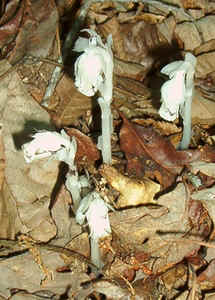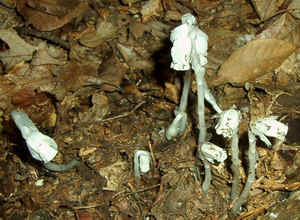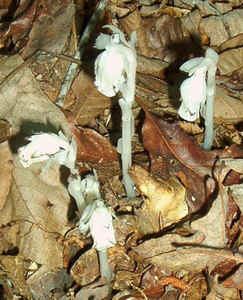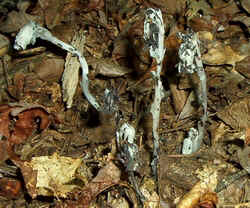 |
 |
 |
 Disintegrating |
Common Name: Indian Pipes, Corpse Plant, Ghost Flower, Ice Plant
Scientific Name: Monotropa uniflora
Family Name: Ericaceae
Serendipity Ranch
Columbus, North Carolina
June 8, 2002
 |
 |
 |
 Disintegrating |
These pale, low, fleshy, saprophytic perennials, sometimes mistaken for fungi, are in the same family as Rhododendron. The nodding flowers, about 3/4 inch long, are basically similar to those of other members of the Heath family. The stems straighten so that the capsule is erect. A northern and eastern species found in deciduous woods at scattered localities throughout our state. June-October [Justice, William S. and Bell, C. Ritchie, Wild Flowers of North Carolina. University of North Carolina Press, Chapel Hill, 1968]
Although you may mistake it for a fungus, Indian pipe is in fact a flowering plant. It lacks the green pigment chlorophyll and so can not make its own food. Consequently, it lives as a saprophyte, garnering nourishment from decaying organic matter in the soil. Upon fertilization, the flower will turn upright, which may explain the genus name Monotropa (one-turn). Cherokee legend claims that long ago the Cherokee god caught the seven clans' leaders smoking peace pipe before an argument had been settled. Infuriated, he destroyed the council. As a reminder, Indian pipe now grows in places where kin once argued. [White, Peter, Wildflowers of the Smokies. Great Smoky Mountains Natural History Association, Gatlinburg, 1996]
Indian pipe does not fit in with the normal idea of a wildflower. It resembles fungi more than the leafy, green plants usually thought of as wildflowers. Chlorophyll, the substance which gives plants their green color and changes the sun's energy to food, is absent from Indian pipe. To get food, Indian pipe forms a symbiotic relationship with a fungus growing on its roots. As the fungus breaks down organic matter for its own food, nutrients are absorbed through Indian pipe's roots. The white, ghostly appearance and the plant's tendency to turn black and "melt", or decompose when touched, is the source of Indian pipe's other common names. The stem also turns black after pollination. Indians used the plant's juices to make an eye wash, and t one time, doctors made a sedative from the roots. [Adams, Kevin and Casstevens, Marty, Wildflowers of the Southern Appalachians: How to Photograph and Identify Them. John F. Blair, Publisher, 1996]
January February March April May June July August September October November December
Alphabetical Listings -- A B C D, E F G H I, J, K L M N, O P Q, R S T U, V W X, Y, Z
Family Listings -- A B C D, E F G H I, J, K L M N, O P Q, R S T U, V W X, Y, Z
Genus Listings -- A B C D, E F G H I, J, K L M N, O P Q, R S T U, V W X, Y, Z